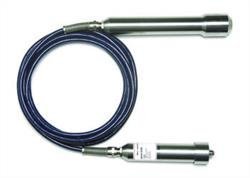How to choose a water depth level logger!
How to choose a water depth level logger! |
 | Water depth loggers are widely used for groundwater monitoring, gauging river and creek depths, flood level recording, and bore monitoring. They can also be used for more specialised applications such as monitoring fish swimming depth. In this article we will go through how to choose a depth logger for your application. | |||
Vented vs Non-vented Water depth loggers can be broken into two main categories: vented and non-vented. Vented loggers have a tube that connects them to atmospheric pressure so that the logger automatically corrects for barometric pressure. Without this the logger would measure the pressure of the water and the barometric pressure together and report inaccurately. The main advantage of vented loggers is that they can provide very high accuracy even as barometric pressure changes. The main disadvantages are that they tend to be bulkier, trickier to deploy (there can’t be any kinks in the vent cable), require more maintenance, and are at higher risk of damage due to unexpected water rises which can flow into the vent tube. Non-vented loggers don’t have a vent tube, so instead the barometric pressure must be accounted for by either using data from a local weather station, or a separate pressure logger mounted at ground level. Non-vented loggers are typically more compact, require less maintenance, and are less at risk from flood water. The main disadvantage of non-vented loggers is that a source of barometric must be used for barometric pressure compensation and this may require post processing in software. Some non-vented loggers may have a barometric pressure sensor incorporated and connected by a cable to compensate for barometric pressure so that no post processing is required. For stream or freshwater monitoring, non-vented vs vented comes down to personal choice, accuracy and ease of deployment. For sea water applications, non-vented loggers would be recommended due to the ease of deployment.
Connection method For all loggers you will need a method to connect to the logger for setup and download. For the
HOBO U20 loggers (like the
U20L-02) you will require the
BASE-U-4 USB optic base station. Similarly, for the Star-Oddi
depth loggers (like the
DST milli-TD-1-250) you will require the
Commbox-Milli and
SeaStar software. The disadvantage of this style of download is
that the logger must be retrieved
to download. For the
MX2001 series of water level data loggers all that’s required is
an iOS or Android app with
the
HOBOmobile app installed
and the logger can remain in place whilst the data is offloaded.
Housing material The choice of housing material is important when choosing a water depth logger. If you are
planning to deploy your logger in
salt water you will need a logger with a Titanium, plastic or ceramic housing. If it’s only
going to be deployed in a freshwater
environment then plastic, ceramic, or stainless steel can be used (Titanium can also be used but
it is generally more expensive).
The Star-Oddi range of depth loggers are made from a biocompatible ceramic so they can be
inserted internally in fish and
marine animals.
If you’re still unsure about what depth logger you need, please contact our scientists on 1300 737 871. | ||||
See our other newsletter articles here!
Contact our expert scientists now to get the right meter or data logger to suit your needs and discuss your project.
Phone: 1300 737 871
Email: [email protected]


